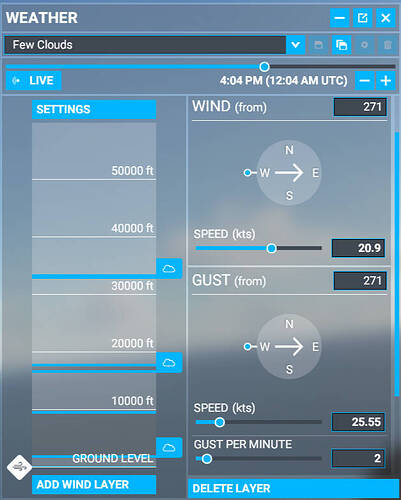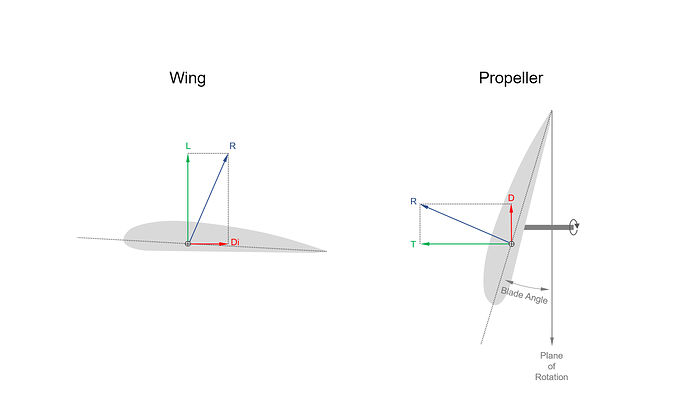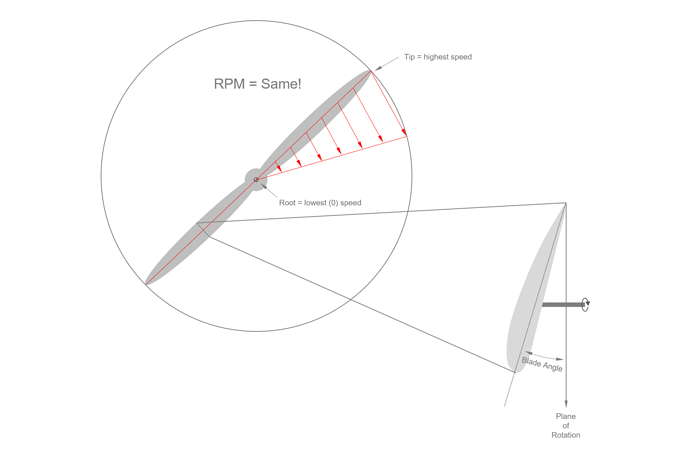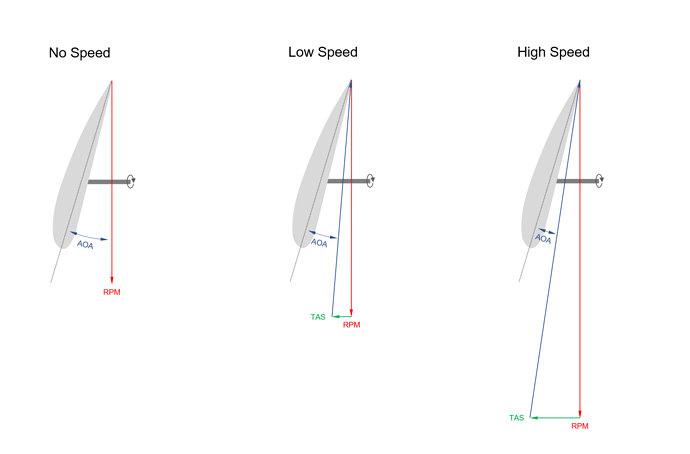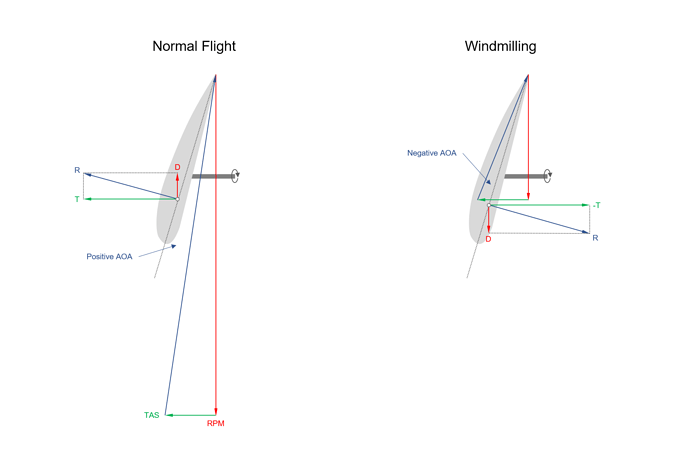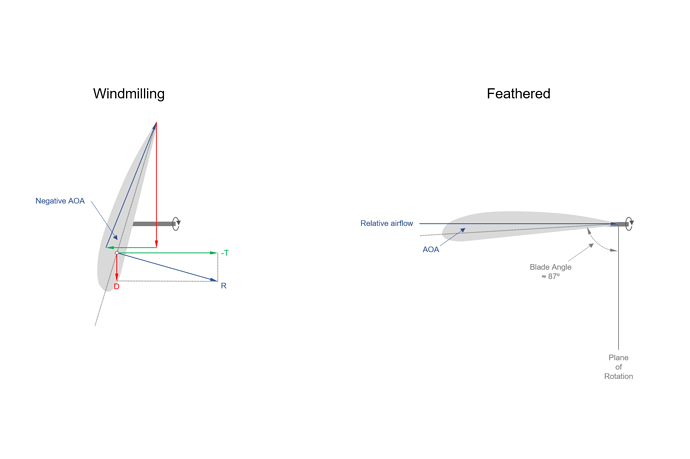In addition, we can have some fast voting system with live payments income attached, and a new economical system created under the platform of MSFS20xx-Money ideas, and every month we can have new features to the simulator, with real ideas, not simple bug physics, that take months to resolve.
By the way if all of you care for our hoping, this is no great task for Asobo Team of finances… We don’t care for 50-100 USD every two months relative to the hoping time wasted in our autopilot trading…
Regarding crosswinds / gusts, the wind interface looks a bit different after the update with the option of setting both direction and speed in kts for the gusts.
(Or, they changed it earlier and I hadn’t seen it 'til now.) 
Oh, now that looks promising 
That is really great, Thank you for sharing, but do you know how much time does it take to change some values in the complex equations of physics in order to add some decoration to the graphics of Wind menu?
Yeah that’s new in this Update
Maybe you should stop hoping, do some testing of your own, post videos for everyone else to assess, so far I’ve only seen you posting X-plane video’s. I believe you were the one asking for videos all the time, its time to deliver now…
So far I’m not convinced this has been a good use of anybody their time. Think we would have gotten to the point much quicker without your expertise and outstanding knowledge about physics. I hope you have learned something from all the valuable time we have invested into educating you at least ![]() . Anyway you could also make yourself useful by voting these items up:
. Anyway you could also make yourself useful by voting these items up:
I have searched for the voting, Where is it, I already liked. PLEASE send me the link for voting, didn’t see the voting click.
The links are in that post. The blue text.
For entertainment purposes. I wanted to say it did not prove anything, but then I realized that the airplane simulation actually went all the way to the runway, without suddenly doing something way out of the ordinary. I also proved that you can be outside of the airplane, and the controls can still react! You don’t have to be inside to control it after all. Not in 2020 but in FSX. I proved that a person could actually do a video, and then the debate would finally, wait for it! go on for another month. I Proved that I could land in a simulator, an airplane that my father worked on, and never had a clue what it took to actually fly it. But because he knew his math the airplane flew! Was Flyable. But he knew that because Leo Sullivan told him the night before he made history that he was going to fly the airplane before the scheduled time. Where to be to see history the next day. “Pilots can be a bit of a daredevil” but they for the most part are mostly just cautiously confident when they are. I proved that even when you put 15knots in on FSX it does not always register there either .as you can see on the upper left it was showing variable wind directions at 5. I also gave you an example of what I can do so that you know I am not exaggerating or completely off when I say this program needs to be programed first to be called a program. Right now it’s a Modicated mess, that is being made while we attempt to show them what it is they actually missed
Can’t help you there since I’m not part of the dev-team and without having access to the source-code: one can only guess. Not sure what type of answer you’re hoping for here…
But the formulas for calculating wind vectors / gust components are far from rocket science, and exposing/linking a variable to the UI-sliders/fields in the wind menu would be very easy since the most of the work was already done.
I know you can’t help me with anything over here, But Since I have to say, if you look at the date, of my previous post, if you find it, regarding the menu of the wind in the previous version? which was three days ago, and I wrote: “Let’s assume that I am wrong … Ok, Now hear the joke, Asobo and Microsoft give such an outstanding Marketing video… Because most of the users don’t understand real physics and most of them are not pilots…So they claim they have created a real weather engine. With thousands of vectors and wind factors… Like real dynamic weather, that changes in time… But see the joke… Do you know what kind of mathematics and algorithms are needed for such a task?”
If you look at the menu and compare it to the previous one, You will see there is no substantial change to the engine that produces the wind, I am quite sure the “engine” or whatever code is present in the simulator doesn’t simulate real environments, of hills influencing wind direction or anything suggested in the marketing video presenting the so-called “weather-engine”.
The point I wanted to make, if you compare the previous wind menu, to the new one, you will see that the only change is made to the shape of the wind direction indicator, an additional word “from” is added, and the Frequency of the gusting is changed from a number of gusting in “seconds” which is also unrelated to weather terms in professional weather forecasts, to more common notations of the highest speed of gust factor. Now, in three days this menu was changed from the time it was announced on this thread, The question is why it was changed at the last moment? Have you tried to think about it? Can you conclude what exactly does it represent in the mind of the developer? Let me give you my humble opinion about it… Professional Aviators that take the terms used in aviation very seriously like all of you over here, If the developers are serious about aviation, and they take the users and product very seriously, respecting the knowledge of the users, and the level of those that would like to enjoy the simulator like professional flying, would make sure that everything in the simulator is truly professional, after the development of 5 years and having pilots on the team, to make sure the simulator is perfect as the graphics of the simulator are perfect. BUT! if you have looked at the previous wind menu, you will conclude that the developer doesn’t really think that serious aviators will use the simulator, and it not important to use aviation and correct weather terms in the simulator, because the user will not be so serious as to set the right units as presented in real weather forecasts. Can you conclude what I am saying? If this is the attitude of the developer to the users, the question rises has the developer have the same attitude in other areas of the simulator, like the physics engine? If you believe not, I will start proving it… and then you might be aware of how business is been done. Now if you don’t agree with me, please give a real physics example of the difference of physical units used in the New wind menu to the previous one. I am open to see your great analytical skills.
Great ! I very much agree with your analytical evaluation what the Medicated Mess needs to see, But the problem is that it doesn’t prevent the developer to put some serious work and make the simulator have functions that will enable the serious users enjoy it as serious flyers. It only takes more work to create a menu that will enable more real factors, as described by other users over here, but to make marketing videos and give false information to users, about a great weather engine, and great physics engine, after the masses pay 130 USD to have the real product, and then find out that simple rules of physics don’t work. Does that sound ethical to you business wise?
Here is an example of a very wise user, Watchfulland959 presented a simple proof, in his post " WatchfulLand959Tech Alpha Insider
I have a Zendesk ticket open for over 10 months (renew it every time) regarding much more forces attacking aircrafts in flight.
The question is for what reason the Zendesk Ticket is open for 10 months? Why does Watchfulland959, need to renew his ticket for 10 months and the developer doesn’t solve the problem? can anyone guess what would be the wise humble reasoning to this ticket problem…
If the physics engine is really present, how much time does it take to resolve this physics problem?
If the menu is created with “Beginner” level to have crazy physics present in the simulator for the moderate mass to enjoy autopilot flying and boring safe flying, and another option of “Professional Pilots” so that real serious pilots like all of you here to enjoy, Then what is the problem? if the engine is present in the simulator? it takes less than 10 days at the most to create such a menu IF the engine is present. But if it is not, then I guess Houston we have a problem…
I think we need to move the serious discussion about the flightmodel to another thread. Here everything immediately gets buried in a pile of ![]() . I’m suggesting to use this one for further conversation:
. I’m suggesting to use this one for further conversation:
Am I making you upset? For what reason you will be upset from my Analysis… Are you a professional to use the words of pile of  in order to get your upset-ness some logic? May be you are competing on who makes the change in Microsoft physics?
in order to get your upset-ness some logic? May be you are competing on who makes the change in Microsoft physics?
Crash Course in Propeller Aerodynamics
Concerning the last Developer Q&A, I’m not entirely sure the developers understand the problem of “missing propeller drag” in the sim. Seb was talking about drag from internal engine components instead of aerodynamic propeller drag. In all fairness, the drag of internal engine components had an effect on propeller windmilling speed and therefore aerodynamic drag produced by the propeller. I’m not a developer to be clear but I doubt this is the real problem. Also it would not explain the lack of drag on turboprops in MSFS as the PT-6 for example is a free turbine engine and therefore not influenced by drag of the engine itself, sure it has some drag from the reduction gearbox and power turbine, but I don’t think this is the real problem.
Edit: after doing some testing it seems like there is propeller drag modelled on certain aircraft. The single engine piston aircraft I have tested seem fairly accurate, the Baron isn’t accurate at all, the landing gear on the Baron does not produce any noticeable drag & able to fly way below Vmca without departure from controlled flight. All three turbo-props have no propeller drag modelled at all. None of the MSFS aircraft have the ability to feather the propellers although on the Kingair and TBM the RPM does drop significantly when selecting feather (but with no change in aerodynamic drag). In short: multi-engine piston aircraft and all three turboprops are significantly flawed.
Definitions
First it is important to understand the following definitions when talking about propellers:
- Blade / Pitch angle - This is the angle between the propeller plane of rotation and the chord line of the blade. On a fixed pitch propeller this angle is fixed, on a Constant Speed Propeller (CSP), this angle is adjusted to balance engine power and propeller power absorbed, controlling the propeller RPM.
- Washout or twist - The blade angle on a propeller blade is not the same along the whole range of the propeller, as the propeller rotates, the root of the propeller has a lower tangential velocity when compared to the tip of the propeller (compare this with a baseball bat, the tip of the baseball bat has a higher velocity compared to the root). In order to have the same angle of attack on the whole propeller blade the blade angle on the tip is lower than on the root (twist or washout).
- Windmilling - Is the condition describing the propeller rotating by the forward speed of the aircraft rather than by absorbing power by the engine. When a propeller is said to be windmilling, the propeller is driving the engine instead of the engine driving the propeller. Windmilling is caused by a negative angle of attack on the propeller blade, essentially producing negative thrust (drag). You can look at it as a thrust reverse without having a negative blade angle. The windmilling RPM of a propeller is depending on the drag from the engine (in that regard the devs. are right) and aircraft forward airspeed (TAS). Lower RPM = lower drag, higher RPM = higher drag.
- Forces - There are a lot of forces acting on a propeller, we will be looking at Lift (thrust) and Drag, the rest of the forces are of importance when trying to understand constant speed propellers. Centrifugal Twisting Moment (CTM), Aerodynamic Twisting Moment (ATM), centrifugal (feathering) weights added to the proppeller, springs in the propeller hub etc. we will skip those for now.
- Fine & Coarse Pitch - On a constant speed propeller the blade angle is variable, a small blade angle is called “fine pitch” while a large blade angle is called “coarse” pitch. The finest pitch possible is the low pitch stop in flight and reverse pitch on ground (if installed), the most coarse pitch is the feather position (if installed).
Basics Aerodynamics
A propeller is an aero foil and essentially behaves like a aircraft wing orientated in the vertical plane. The working principle of a propeller is the same as for a wing, the only difference is that the resultant force is acting mostly vertical on a wing and can be divided into a vertical component (lift) and a horizontal component opposing the direction of movement (Induced Drag), on a propeller this resultant is acting mostly horizontal and can be divided into a horizontal component (Thrust) and a vertical component (Drag).
Very important, this is not the drag we are talking about in regard to the missing aerodynamic drag from (windmilling) propellers!
The engine power has to overcome the drag produced by the propeller, if the two are in balance the propeller RPM is constant, if the engine is producing more power than the propeller is absorbing, the RPM increases, increasing the thrust (and drag) until the two forces are in balance again and vice versa when reducing power.
Regarding constant speed propellers, this becomes a little more complex as there is an extra variable introduced. The propeller blade angle is variable, a constant speed propeller is able to MAINTAIN a certain RPM with an increase or decrease in engine power by modifying the blade angle, therefore changing the power absorbed by the propeller (higher blade angle is more drag and vice versa). For example if engine power is increased, the propeller tends to speed up but the blade angle is then increased producing more thrust (and drag), the increase of power is absorbed by the propeller with no increase in RPM! There is a limit to this, when power is reduced far enough the propeller will eventually reach the minimum blade angle, if power is reduced further the RPM will drop, if power is reduced further then at some point the propeller will start to windmill and drive the engine instead.
Propeller Angle of Attack
The angle of attack on a propeller is based on two components, the tangential velocity of the propeller and the True Airspeed. The tangential velocity of the propeller is depending on the propeller RPM, higher RPM is higher velocity and vice versa. We can’t call it “RPM” because the RPM is the same for the entire propeller, whereas the tangential velocity is not, it is depending on the location of the propeller, the tip of the propeller having the highest tangential velocity and the root having the lowest (zero velocity). To keep it simple we will call this component RPM, but technically this isn’t correct. I hope the picture below also illustrates clearly how we are looking at the propeller cross section in further examples.
In the first example the aircraft is stationary (TAS = 0), the propeller has a high angle of attack (AOA = blade angle) creating high drag on the engine. If we now release the brakes and start rolling the TAS increases which reduces the angle of attack, the reduced angle of attack causes a reduction in drag. The engine is now producing more power than the propeller is absorbing and therefore the RPM increases. This increases the angle of attack again to bring it back in balance, this is the constant force balance in play during flight. It is also the reason why on a fixed pitch propeller (e.g. Cessna 172) the RPM increases with increasing airspeed for a given engine power setting and vice versa.
Windmilling
Now the core of the issue. What happens if the we reduce power all the way to idle in flight? If the engine is not producing any power why doesn’t the propeller (and therefore engine) stop rotating? As soon as the engine fails or power is reduced to idle, the RPM drops significantly as the propeller absorbs more power than the engine is producing, eventually the angle of attack on the propeller becomes negative and the forces acting on the propeller will basically flip. Positive thrust becomes negative thrust (THE DRAG WE ARE MISSING IN MSFS) and drag becomes the driving force, keeping the propeller and engine rotating. This drag is very significant in real life and cuts the glide ratio short by a significant amount, the deceleration in real life is therefore also significantly higher than in MSFS and it is possible to make steeper approaches without picking up speed.
Note that a windmilling propeller basically acts like a thrust reverser, but at a positive blade angle.
Single Engine versus Multi-engine
Without diving deep into the working principle of a Constant Speed Propeller, Propeller Governors etc. There is a noticeable difference between single engine and multi-engine aircraft. The principles are all the same independent if we are talking about single-engine, multi-engine, fixed pitch or constant speed propellers. Also on a constant speed propeller the engine will windmill, the reason is simple, a constant speed propeller (it is in the name) wants to maintain a constant propeller RPM. If an engine fails or power is reduced to idle the constant speed propeller will drive the propeller to the fine pitch stop and from there it will essentially behave like a fixed pitch propeller.
Belief it or not, windmilling on a single engine aircraft is actually beneficial. From an aerodynamic and glide range standpoint, windmilling obviously isn’t a great benefit. But only having one engine, the main priority should be to restart the engine, windmilling of the propeller keeps the engine turning and increases the possibility of restarting the engine in flight. This is the principle difference between single and multi-engine aircraft. On a multi-engine aircraft an engine failure will not only cause asymmetric thrust, on top of this the windmilling propeller will cause a load of drag. On a multi-engine aircraft the priority is therefore to reduce the drag, secure the engine and continue flight on the remaining engine.
Reducing the drag of the propeller and stopping the engine is done by “feathering” the propeller. The blade angle is increased to a near 90 degrees which results in zero resulting force on the propeller blade, the propeller stops rotating and drag from a windmilling propeller is canceled. Feathering can be accomplished manually or automatically by the aircraft (i.e. auto-feather). Nice detail, the propeller blade angle when feathered is not exactly 90 degrees (few degrees lower in fact), if the propeller blade angle would be increased to 90 degrees the propeller blade would start to act like a wing and will produce a slight lift force (and therefore drag), the angle of attack is therefore kept slightly negative.
This is exactly the next problem in MSFS, last time I checked propellers are not able to feather, neither does the propeller produce drag as we know so the propeller performance in MSFS is basically a feathered prop anyway. When propeller drag becomes implemented feathering would become very important. At this moment, accurate simulation of asymmetric thrust and drag on multi-engine aircraft is unavailable.
In all cases below, flight model set to MODERN, assistance set to HARD, community folder completely emptied, ISA conditions, no wind.
TBM 930
Maximum weight, 120 kts glide speed, flown with FLC on autopilot, prop first feathered and then windmilling. I cut the engine (by closing fuel selector) overhead an airport at 3000 ft, ISA, no wind, glided down to 0 feet, paused the sim, took the drone camera to check my location, looked it up on Bing maps and measured the distance.
Prop. Feathered:
Propeller speed = 260 RPM
Glide range: 17.5 km = 57400 ft
Glide ratio = 57400 / 3000 = 1:19,13
Prop. windmilling:
Propeller speed = 960 RPM
Glide range: 17.1 km = 56088 ft
Glide ratio = 56088 / 3000 = 1:18,70
My methods are a little bit mickey mouse and completely accurate, the autopilot started to level off slightly when doing the glide ratio test with feathered propeller because I put 0 ft in the altitude preselect so thats were the extra 400 m likely comes from. It is safe to assume that there is absolutely no drag modeled on the TBM…
Next test, FLC at 120kt in descend, measuring vertical speed:
Flight idle: -700 ft/min
Windmilling: -650 ft/min
Feathered: -700 ft/min
Full reverse: -900 ft/min
Conclusion, no windmilling drag at all. In all situations the vertical rate is fluctuating between 650 and 700 ft/min.
Beechcraft G36 Bonanza
Speed 110 kts at FLC, max. weight:
Power idle: -1100 ft/min
Engine off: -1300 ft/min (mixture cut-off)
Low RPM: -1100 ft/min (mixture cut-off and prop full back)
Below, same test as TBM, power cut at 3000 ft overhead an aerodrome. Mixture cut-off, prop in low RPM, 110 kts at full weight according to the POH it should result in a glide ratio of 1.7 nm per 1000 ft.
Glide range: 4.9 nm
Glide ratio: 4.9 / 3 = 1,64 nm per 1000 ft
Conclusion, the G36 is pretty accurate! Maybe the problem only concerns turboprops?
Beechcraft Baron
Speed 110 kts at FLC, max. weight:
Power idle: -1000 ft/min
Engines off: -1450 ft/min (mixtures cut-off)
Props feathered: -1450 ft/min
Conclusion, not sure if the increase in rate if descent is because of losing idle thrust or if it is because of propeller drag. The props don’t feather, absolutely no response to propeller lever (RPM stays the same when feathering). Interestingly I accidentally left the gear down during this test so I rerun the test with gear-up with same results! The landing gear on the Baron does not seem to create a noticeable increase in drag.
Beechcraft Baron - Vmca demonstration
Beechcraft Baron
One engine full power, the critical engine windmilling
Take-off flaps, gear-up
ISA conditions
Max. TOW, aft CG
Seems the aircraft stalls before losing control due to asymmetric thrust and drag. I haven’t flown the Baron myself but I have heard stories about how it is handling single engine go-arounds and I even know someone who died practising single-engine go-around on a Baron. Can anybody with experience on the Baron confirm whether this behaviour is correct? Is it still climbing this well on one engine with flaps at take-off at speeds way below Vyse?
By the way the rudder axis on my joystick is seriously borked so I’m lacking precise control over the rudder…
Edit: I noticed I shutdown the wrong engine, I had the right engine in my head as being critical, forgot that the aircraft I used to fly has counter rotating props, oops…
Second attempt: now with the critical engine failed, 50% payload, gear down for some extra drag, first one flaps take-off, second one flaps landing:
Beechcraft Kingair
The Beechcraft Kingair is an absolute joke. I have flown this aircraft in real life, I can see it is seriously flawed.
Max. take-off weight, speed 140 kts on autopilot using FLC:
Power idle: -300 ft/min
Full reverse: -1150 ft/min
Engines shutdown, props full forward: -850 ft/min
Props feathered: -850 ft/min
I didn’t note the RPMs, the RPM does drop significantly when selecting feather, but with no effect on the aircraft drag. The difference between flight idle and engines shutdown is likely not an increase in drag but rather a way too high flight idle power setting…
When shutting down the critical engine (windmilling) and adding full power on the life engine, the aircraft stalls way before running out of rudder to counter the asymmetric thrust and drag. Second try with flaps in landing position to lower the stall speed, able to fly just 77 kts with the joke full back, rudder full in just keeping the slip indicator centered, again no departure from controlled flight below Vmca.
Cessna Caravan
Max. take-off weight, 110 kts on FLC (no idea what best glide speed is, I just picked a speed).
Power idle: -650 ft/min
Full reverse: -1050 ft/min
Engine shutdown, prop full forward: -900 ft/min
Prop feathered: -900 ft/min
On the Cessna Caravan the prop RPM does not respond when selecting feather. RPM remains the same. Conclusion, the three turbo props seem to suffer the most from incorrect (completely missing) propeller drag…
I caught that, too, and agree. This crash course material does a good job of presenting – and explaining – just how simple something like propeller dynamics can look versus how complex it can be in reality. And translating those dynamics into equations and programming them in simulation software is very, very challenging.
I agree that these type of discussions will probably be more productive in the other thread.
By the way, congratulations on getting some of your Q&A submissions discussed in the live stream. You’re famous now that Jayne mentioned you by name. I’m not saying your questions made you famous – it was more how comical it was when she butchered your tag.
That’s why I call you “Ninja” – I’m a simple man. Perhaps you should have chosen a more pronounceable tag like our friend DerangedDoughnut did.
Indeed and this is far outside my area and level of knowledge. I know how these things work in real life, but programming those things realistically, I have no knowledge how to do that.
Haha, Nijnje is a cartoon for children in the Netherlands (pronounced as Nyntje), I didn’t know what name to use so I started to use this as a joke and haven’t changed it since ![]() . It is in line with the maturity of the average pilot though …
. It is in line with the maturity of the average pilot though …

You are so creative, Wonderful writing, and explaining. It would be great, if you make videos of all these lessons on youtube, I am sure, many users will stop flying on autopilot, and start learning real stuff…
Could be, propeller drag has multiple definitions. I think you are right but not completely sure. I mean this is kind of, but not entirely:
Emphasis is put in the friction of engine components, while this is related it is not the core of the problems we are facing. I think his explanation is mainly about the relationship between drag of internal engine components and windmill RPM.
IF it is simulated at all it isn’t simulated accurately as it is way too weak, especially on turboprops. I have flown the Kingair in real life, the deceleration is nowhere near what it should be. Also on single engine piston aircraft it isn’t accurate in my opinion.
I did run a test couple of updates ago, so maybe I need to rerun it, but on the TBM there was absolutely no difference between flight idle, prop feathered (or at least feather selected) and full reverse in flight.
I also ran this test (although long time ago so maybe invalid now):
I don’t remember what Seb said the L/D ratio was of the TBM yesterday but I believe it was around 16/17 for just the airframe, so glide ratio around 18 is not too bad (for just the airframe! Not taking into account propeller drag). I will test it again tomorrow and see if it is still the same.
